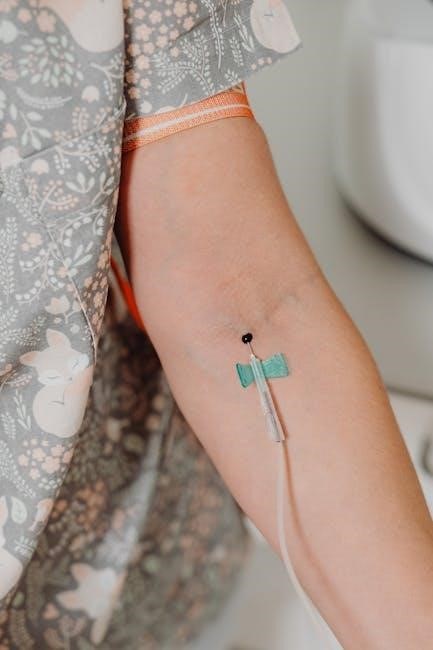This edition emphasizes patient-centered care, focusing on safe drug administration and individualized therapy. It provides a clear framework for understanding pharmacology in nursing practice.
Overview of the 11th Edition
The 11th edition of Pharmacology: A Patient-Centered Nursing Process Approach provides a comprehensive update on drug therapy, emphasizing patient safety and evidence-based practice. Published in May 2022 by Saunders, it features updated drug information, new prototype drugs, and expanded content on legal and ethical considerations. The edition includes a study guide with practice questions and case studies to enhance learning. It also focuses on the nursing process, offering practical guidance for assessment, planning, and evaluation of drug therapy. This edition is available in print, PDF, and e-book formats, making it accessible for nursing students and professionals. Key updates include new NCLEX-style questions and a stronger emphasis on patient-centered care.
Importance of Patient-Centered Care in Pharmacology
Patient-centered care is a cornerstone of pharmacology, ensuring treatments are tailored to individual needs and preferences. This approach emphasizes collaboration between nurses and patients to achieve optimal therapeutic outcomes. By focusing on patient-specific factors, such as medical history, lifestyle, and genetic predispositions, nurses can customize drug regimens to maximize efficacy and minimize adverse effects. The 11th edition highlights the role of patient-centered care in improving medication safety, adherence, and overall health outcomes. It underscores the importance of cultural competence, effective communication, and shared decision-making in pharmacological interventions. This personalized approach not only enhances patient satisfaction but also aligns with evidence-based practices, making it a critical component of modern nursing care.

Core Principles of Pharmacology
Pharmacology’s core principles include pharmacokinetics, pharmacodynamics, drug interactions, and therapeutic indexes. These concepts guide safe and effective drug therapy, ensuring optimal patient outcomes and minimizing risks.
Key Concepts in Drug Therapy
Drug therapy revolves around understanding drug prototypes, pharmacokinetics, and pharmacodynamics. Nurses must assess patients’ unique needs to tailor drug regimens effectively. Individualization is crucial, considering factors like age, weight, and organ function. Therapeutic ranges and adverse effects guide dosing to maximize efficacy while minimizing risks. The nursing process ensures systematic care, from assessment to evaluation. Prototype drugs simplify learning by representing drug classes. This approach fosters safe administration and patient-centered care, aligning with the 11th edition’s focus on practical application and evidence-based practices. The text also integrates legal and ethical considerations, emphasizing accountability in drug therapy. These principles form the backbone of pharmacology in nursing practice.
Pharmacokinetics and Pharmacodynamics
Pharmacokinetics involves the drug’s absorption, distribution, metabolism, and excretion, affecting its concentration in the body. Pharmacodynamics examines the drug’s mechanism of action and receptor interactions. Together, they determine drug efficacy and safety. Nurses must understand these principles to predict drug responses and manage therapy effectively. Factors like age and organ function influence pharmacokinetics, requiring dose adjustments. Pharmacodynamics explains how drugs produce therapeutic and adverse effects. This knowledge is vital for optimizing drug regimens and minimizing toxicity. The 11th edition emphasizes these concepts to ensure patient-centered care and safe drug administration, aligning with nursing responsibilities in pharmacotherapy. Understanding these principles enables nurses to tailor treatments to individual patient needs, enhancing outcomes and safety.

The Nursing Process in Pharmacology
The nursing process in pharmacology involves assessment, diagnosis, planning, implementation, and evaluation to ensure safe and effective drug therapy. It emphasizes patient-centered care and individualized treatment plans.
Assessment and Diagnosis
Assessment and diagnosis are critical steps in the nursing process, focusing on identifying patient needs and actual or potential health problems. Nurses gather data on medical history, current symptoms, laboratory results, and medication use. This information helps in formulating nursing diagnoses that guide individualized care plans. The 11th edition emphasizes the importance of patient-centered care, ensuring interventions are tailored to address unique needs. By prioritizing accurate assessment and diagnosis, nurses can promote safe and effective drug therapy, minimizing adverse effects and enhancing therapeutic outcomes. This approach aligns with the textbook’s focus on drug prototypes and therapeutic use, ensuring evidence-based practice.
Planning and Implementation
Planning and implementation involve developing individualized care plans tailored to the patient’s needs and health status. Nurses set SMART goals to achieve desired outcomes, such as improving symptoms or preventing complications. This phase includes selecting appropriate medications, dosages, and administration routes based on patient-specific factors. Education is a key component, ensuring patients understand their drug regimens and potential side effects. Nurses also monitor for drug interactions and adverse reactions, adjusting plans as needed. Effective implementation ensures safe and effective drug therapy, aligning with the textbook’s emphasis on patient-centered care and evidence-based practice. This step is crucial for optimizing therapeutic outcomes and enhancing patient safety.
Evaluation of Drug Therapy
Evaluation of drug therapy is a critical phase in the nursing process, focusing on assessing the effectiveness of the treatment plan and patient outcomes. Nurses systematically monitor for desired therapeutic effects, potential side effects, and adverse reactions. Patient feedback and clinical data, such as lab results, are essential in determining whether goals are met. If outcomes are not achieved, the plan is adjusted, which may involve changing medications, dosages, or administration schedules. The 11th edition emphasizes the importance of evidence-based practices and continuous monitoring to ensure safe and effective pharmacotherapy. This step ensures that drug therapy is optimized, enhancing patient safety and overall well-being.

Drug Classification and Prototypes
Drug classification organizes medications by therapeutic use or pharmacological effect. Prototypes represent key drugs within classes, helping nurses understand mechanisms, effects, and patient care implications effectively.
Prototype Drugs and Their Mechanisms
Prototype drugs are representative agents within their therapeutic class, showcasing key pharmacokinetic and pharmacodynamic properties. These drugs serve as models for understanding how medications work, helping nurses grasp their mechanisms of action, side effects, and interactions. By focusing on prototypes, nurses can generalize care principles to other drugs in the same class, ensuring safe and effective therapy. Prototypes also highlight therapeutic goals, enabling personalized patient care. This approach simplifies complex pharmacology concepts, making them easier to apply in clinical practice. Understanding prototype mechanisms is essential for predicting drug responses and managing potential adverse effects, ultimately enhancing patient outcomes.
Classification of Drugs by Therapeutic Use
Drugs are categorized by their therapeutic use to guide clinical decision-making, ensuring appropriate treatment for specific conditions. This classification helps nurses understand the primary purpose of each medication, aligning with patient needs. By organizing drugs based on their therapeutic effects, healthcare providers can streamline care plans and minimize errors. This approach also aids in identifying potential drug interactions and contraindications, promoting safer therapy. Therapeutic classification is a cornerstone of pharmacology education, enabling nurses to apply pharmacological knowledge effectively in patient care. It emphasizes the role of drugs in managing diseases and improving quality of life, fostering a patient-centered approach to medication administration.

Legal and Ethical Considerations
Legal and ethical principles guide nursing practice in drug administration, ensuring patient safety, informed consent, and adherence to laws regulating medication use and documentation.
Nursing Responsibilities in Drug Administration
Nurses play a critical role in ensuring safe and effective drug administration. Key responsibilities include accurate assessment of patients, careful planning, and precise implementation of drug therapy. Patient education is essential, focusing on proper medication use, potential side effects, and adherence to treatment plans. Nurses must also monitor for adverse reactions and document outcomes thoroughly. Legal and ethical standards, such as maintaining patient privacy and following medication administration protocols, are paramount. Collaboration with healthcare teams ensures comprehensive care, aligning with patient-centered approaches outlined in the 11th edition of Pharmacology: A Patient-Centered Nursing Process Approach.
Ethical Issues in Pharmacotherapy
Ethical issues in pharmacotherapy are central to patient-centered care, requiring nurses to uphold principles such as autonomy, beneficence, nonmaleficence, and justice. Key concerns include patient rights, informed consent, and confidentiality. Nurses must balance therapeutic benefits with potential risks, particularly in vulnerable populations. Access to medications, especially costly or experimental drugs, raises ethical dilemmas. Additionally, end-of-life care decisions and genetic therapies introduce complex moral questions. The 11th edition emphasizes the importance of ethical decision-making frameworks to guide nurses in navigating these challenges while advocating for patients’ best interests. These principles ensure that pharmacotherapy aligns with professional standards and promotes equitable, compassionate care.

Special Populations and Drug Therapy
Special populations, such as geriatric, pediatric, and pregnant patients, require tailored drug therapy approaches due to unique physiological and metabolic differences. The 11th edition highlights these considerations.
Gerontologic Considerations
Gerontologic considerations in pharmacology focus on age-related physiological changes affecting drug responses. Elderly patients often experience decreased hepatic and renal function, altering drug metabolism and excretion. Polypharmacy is a significant concern, increasing the risk of adverse drug interactions and reactions. The 11th edition emphasizes the importance of tailoring drug regimens to older adults, considering comorbidities and sensory impairments. Nurses must assess for age-related changes in drug absorption, distribution, and elimination to ensure safe and effective therapy. This approach helps minimize complications and improves quality of life for geriatric patients.
Pediatric and Neonatal Pharmacotherapy
Pediatric and neonatal pharmacotherapy requires careful consideration of developmental stages and physiological differences; Children and newborns have unique metabolic rates, organ immaturity, and body composition, affecting drug responses. The 11th edition highlights the importance of weight-based dosing and renal/hepatic function in pediatric patients. Nurses must monitor for age-specific adverse effects and ensure proper drug administration techniques. Neonatal therapies often focus on supporting organ development and treating congenital conditions. The patient-centered approach emphasizes individualized care plans to address the dynamic needs of pediatric and neonatal populations, ensuring safe and effective pharmacotherapy.
Pharmacotherapy in Pregnancy and Lactation
Pharmacotherapy during pregnancy and lactation requires careful consideration of maternal and fetal health. Medications must be evaluated for teratogenic potential and their impact on fetal development. Nurses play a critical role in assessing the risk-benefit ratio of drug therapy, ensuring safe outcomes for both mother and baby. The 11th edition emphasizes trimester-specific drug safety and lactation considerations, including drug transfer into breast milk. Patient-centered care involves educating mothers about medication use, potential side effects, and alternatives. Evidence-based guidelines help nurses make informed decisions, balancing therapeutic needs with fetal and infant protection. Monitoring and adjusting drug regimens are essential to optimize maternal health while safeguarding the developing fetus and newborn.

Common Drug Categories
Common drug categories include cardiovascular, respiratory, and neurologic agents. Each category targets specific body systems, aiding in disease management and improving patient outcomes effectively.
Cardiovascular Drugs
Cardiovascular drugs are essential for managing conditions like hypertension, heart failure, and arrhythmias. They include antihypertensives, anticoagulants, antiplatelets, and vasodilators. These medications work by regulating blood pressure, preventing clots, or improving blood flow. Nurses must assess patients’ cardiovascular status and monitor for adverse effects. For example, ACE inhibitors and beta-blockers are commonly used to manage hypertension and heart failure. Patient education is crucial, emphasizing adherence to prescribed regimens and lifestyle modifications. Understanding drug mechanisms and individualized therapy plans ensures safe and effective care. This approach aligns with the patient-centered nursing process, focusing on optimal outcomes and minimizing complications. Regular monitoring of lab values and patient responses is key to successful drug therapy in cardiovascular care.
Respiratory Drugs
Respiratory drugs are crucial for managing conditions like asthma, COPD, and pneumonia. They include bronchodilators, corticosteroids, and mucolytics. Bronchodilators, such as albuterol, relax airway muscles to improve breathing. Corticosteroids, like fluticasone, reduce inflammation in chronic conditions. Mucolytics, such as acetylcysteine, thin mucus for easier clearance. Nurses should assess respiratory status and educate patients on proper inhaler use. Monitoring for side effects, like tremors or oral thrush, is essential. Patient-centered care involves tailoring therapy to individual needs and lifestyle, ensuring adherence and optimal outcomes. Regular follow-ups and adjustments in treatment plans are vital for effective respiratory management and improved quality of life.
Neurologic and Psychiatric Drugs
Neurologic and psychiatric drugs target conditions like epilepsy, depression, and schizophrenia. Antipsychotics, such as haloperidol, manage psychosis by blocking dopamine receptors. Antidepressants, including sertraline, regulate neurotransmitters like serotonin. Anticonvulsants, like carbamazepine, stabilize neuronal activity. Nurses assess mental status and monitor for side effects, such as extrapyramidal symptoms or serotonin syndrome. Patient-centered care involves tailoring drug regimens to individual needs and lifestyles. Education on adherence, potential interactions, and symptom management is crucial. Regular monitoring ensures therapeutic efficacy and minimizes adverse effects, promoting improved mental health and quality of life for patients with neurologic or psychiatric conditions.

Safe Drug Administration Practices
Emphasizes medication safety, error prevention, and proper drug administration techniques. Focuses on using drug prototypes and ensuring accurate dosages to enhance patient outcomes and reduce risks.
Medication Safety and Error Prevention
Medication safety is a critical aspect of pharmacology, focusing on preventing errors and ensuring accurate drug administration. The 11th edition emphasizes strategies to minimize adverse events, such as using the “five rights” of medication administration: right patient, right drug, right dose, right route, and right time. It highlights the importance of double-checking prescriptions, monitoring for adverse reactions, and utilizing barcode scanning technology to reduce errors. Nurses are encouraged to adopt a systematic approach to medication administration, incorporating patient education and clear communication. The book also discusses the role of drug prototypes in identifying potential risks and improving therapeutic outcomes, ensuring safe and effective care for all patients.
Adverse Drug Reactions and Management
Adverse drug reactions (ADRs) are unintended and harmful responses to medications. The 11th edition highlights the importance of early identification and management to prevent complications. Nurses play a key role in assessing patients for signs of ADRs, such as rashes, gastrointestinal disturbances, or changes in vital signs. Management strategies include discontinuing the offending drug, administering antidotes if available, and providing supportive care. Patient education is critical to ensure awareness of potential side effects and the importance of reporting symptoms promptly. The book emphasizes the use of drug prototypes to predict and manage ADRs, fostering a proactive approach to patient safety and therapeutic outcomes.

Pharmacology in Specific Clinical Settings
This section explores pharmacotherapy in unique environments like critical care and oncology, emphasizing specialized drug therapies and monitoring to optimize patient outcomes in high-stakes settings.
Pharmacotherapy in Critical Care
Pharmacotherapy in critical care requires precise drug selection and titration to manage life-threatening conditions. Drugs like vasoactive agents, sedatives, and analgesics are commonly used to support organ function and patient comfort. The critical care setting demands a deep understanding of pharmacokinetics and pharmacodynamics due to factors like hemodynamic instability and organ dysfunction. Nurses play a pivotal role in monitoring drug responses and adjusting therapies to prevent adverse reactions. Tailored pharmacotherapy plans are essential to address individual patient needs, ensuring optimal outcomes. The 11th edition emphasizes evidence-based practices and patient-centered approaches in critical care, providing guidance on managing complex drug regimens effectively.
Pharmacotherapy in Oncology
Pharmacotherapy in oncology focuses on the use of drugs to treat cancer, emphasizing targeted therapies and precision medicine. Chemotherapy agents, along with biologics and immunotherapies, are central to treatment plans tailored to individual patient needs. Nurses play a critical role in managing side effects, such as nausea and neutropenia, while ensuring safe drug administration. The 11th edition highlights advancements in oncology pharmacology, including hormone therapies and monoclonal antibodies. Patient education on drug regimens and symptom management is essential. The book underscores evidence-based practices to optimize outcomes and improve quality of life for patients undergoing cancer treatment, aligning with a patient-centered care approach.

Resources for Nurses
The 11th edition offers a study guide, online tools, and a comprehensive eBook, providing nurses with accessible resources to enhance pharmacology knowledge and clinical skills effectively.
Study Guide for Pharmacology: A Patient-Centered Nursing Process Approach
The study guide complements the 11th edition textbook, offering practice problems, NCLEX-style questions, and case studies. It helps nurses master pharmacology concepts, focusing on patient-centered care and safe drug administration. The guide includes critical thinking exercises and clinical scenarios to enhance learning. Available in PDF format, it provides convenient access for review and self-assessment. The guide aligns with the textbook chapters, ensuring a structured approach to understanding key pharmacology principles. It emphasizes practical application, enabling nurses to apply knowledge in real-world settings effectively. This resource is essential for nurses seeking to improve their pharmacology skills and prepare for professional exams.
Online Resources and Tools for Pharmacology Education
The 11th edition of Pharmacology: A Patient-Centered Nursing Process Approach offers various online resources to enhance learning. These include interactive modules, quizzes, and case studies that reinforce key concepts. The study guide is available in PDF format, providing convenient access to practice questions and exercises. Additionally, the eTextbook version allows for easy navigation and quick reference. Platforms like Docsity and Google Drive offer downloadable resources, enabling nurses to study on the go. These tools are designed to support both individual and classroom learning, ensuring a comprehensive understanding of pharmacology principles and their application in patient care.
